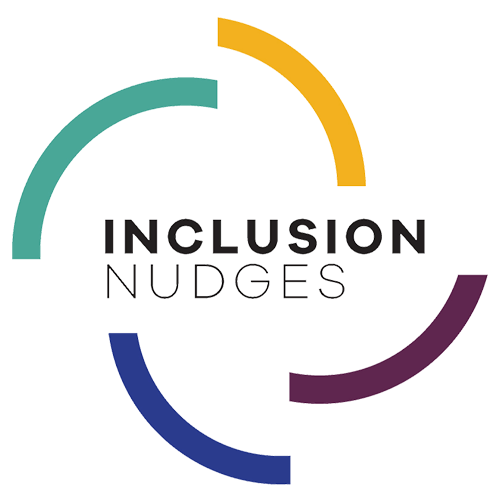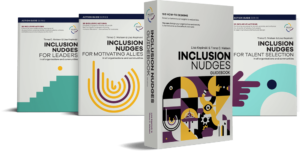This question comes from Misel Ahom, who is the Global Director of Diversity & Inclusion in Beiersdorf, a consumer products multinational. Lisa and Tinna are working with Misel and her colleagues on applying Inclusion Nudges within their D&I strategic framework to support inclusive behaviours and processes.
![]() Dear Lisa & Tinna,
Dear Lisa & Tinna,
How can we ensure that intersectionality is best reflected in KPIs?
Thank you,
Misel Ahom, Global Director of Diversity & Inclusion, Beiersdorf
![]() This is a short but profoundly powerful question, Misel. Thank you for asking it on behalf of all diversity, equity, & inclusion (DEI) change makers. While the question is brief, our response is a bit detailed due to the crucial nature of this topic.
This is a short but profoundly powerful question, Misel. Thank you for asking it on behalf of all diversity, equity, & inclusion (DEI) change makers. While the question is brief, our response is a bit detailed due to the crucial nature of this topic.
Your question gets to what we see and don’t see, what we focus on and don’t focus on, what is changed and not changed—all very important to successfully address inequities. That’s why intersectionality is such an important focus, because it examines discrimination across two or more identities, such as gender, race/ethnicity, age, sexual orientation, abilities, socio-economic level, education, occupation, nationality, and many other factors and identities.
“INTERSECTIONALITY is the complex, cumulative way in which the effects of multiple forms of discrimination such as racism, sexism, and classism combine, overlap, or intersect especially in the experiences of marginalized individuals or groups.” Kimberlé Creshaw
Intersectionality — the concept and the term — was first developed over 30 years ago by Professor Kimberlé Crenshaw who continues to examine systemic inequalities with a lens on the intersections of race and gender, and also other identities. Intersectionality explains how Black women’s experiences are that of both being Black and being a woman.
You can hear directly from Professor Crenshaw on what is intersectionality and its impact in her TED talk on the urgent need for a frame of intersectionality.
Does data only show part of the issues?
For addressing inequalities and to apply targeted change designs, using an evidence-based approach is crucial. But what if there were flaws in our data?
What if we overlooked people within and outside of our systems? What if we over-generalised about communities of people, and thus, lost out on having a full understanding of the complexities of human experiences? What if we acted on a limited picture, while falsely believing that it was the full picture? How effective would our decisions, actions, and solutions be if they were based on a flawed understanding of identity and experiences of all human beings?
Working with such incomplete data would be absurd, wouldn’t it? But the reality is that many DEI initiatives and people analytics tend not to be based on intersectional thinking.
Instead, we use single categories (“women”, “LGBTQ+”, “people with disabilities”, etc.) that create a false concept. It’s as if these categories of people are one homogenous group, each independent of the others. This segregated human outlook often doesn’t include the majority.
The problem with such simplifications of reality is that it contributes to the problems. This frames up that these ‘diversity’ groups of people are ‘the problem to be fixed’ rather than focusing on the deeper systemic issues. The targets that we set for these DEI focal areas reinforce this flawed, biased cognitive model (see more in this blog article). What gets missed, and thus not changed, is the status quo of inequitable processes and behavioural norms.
And we have also ourselves fallen into this trap many times. We are not pointing fingers at other DEI change makers – with this blog post we want to make a call to action to all of us to support each other in remembering to always, always have a focus on the intersections of inequalities and create data that shows the full picture.
Here are some ways that we’ve seen intersectionality not be applied initially but when it was, then a different outcome resulted.
WOMEN – is it only women who have a gender?
Let’s take a closer look at the term ‘gender’. This term is often used as a synonym for women. In practical DEI actions it is primarily focused on only ‘women’ and not others on the gender spectrum. Additionally, the default view of ‘women’ is women from the majority, such as White heterosexual women from Western/European countries. With so many organisations declaring that they will focus on ‘women’, they wind up benefiting majority women and further marginalising women who are not in the majority group. This pattern is invisible with data reporting that only shows women as one collective group, with no breakdowns by other diversity aspects of women.
Here are some examples of how a lack of intersectional perspective shows up.
- A different picture emerges when looking at women + tenure + age: An organisation was really proud of its annual engagement survey results that showed overall women were ‘highly engaged’. But when Lisa asked for additional data cuts, then a very different picture emerged. Women in senior leadership, with 10 years+ tenure, and age 50+ were the least engaged population out of any other. This intersectional data view shook up the false confidence that “all women were highly engaged” and senior leaders felt the need to take action to address this.
- Broadening the view on ‘women’ can change perceptions: A CEO was very supportive of his company’s global goal to hire more women and his strong KPI results reflected this. He asked Lisa for advice on how to let the LGBTQ+ employee group know that he would not be approving their funding request for a Gay Pride event. He saw it as a ‘sexual orientation & gender identity’ issue and not aligned with the women target. Lisa responded with “Lesbians and transwomen are women, too.” He hit his head with his fist and said “Of course!”. He had been thinking of ‘women’ as ‘only heterosexual women’. He sponsored the event and added a big recruiting presence as well.
- Deeper data views on ‘who is harassed?’ gives new insight: A new research paper (2020) about harassment and discrimination in the film and theatre industry in Denmark revealed how women of minorities groups (sexual minorities, ethnic minorities) experience more harassment than white heterosexual women. For many people, this was new insight.
- Do more data breakdowns to reveal the reality: A DEI officer asked for data showing the performance reviews split up in new ways to see the hidden correlations between the gender and age of the manager and the gender and age of the employee. A completely different picture emerged. (you can see more examples in the Inclusion Nudge called ‘Show Hidden Patterns in Performance Calibration Data’-180 in The Inclusion Nudges Guidebook).
RACE/ETHNICITY – is it only Black people who have a race?
From a global perspective, if race/ethnicity is addressed, it is usually focused on only people in the country’s minority groups and rarely includes the majority race/ethnicity. This perpetuates a default that the majority is the norm and all others are the exceptions. This framing blocks examining and redesigning systems that support inequalities.
In terms of data reporting, it is not unusual to see categories of people described simply as ‘White’ and ‘Non-White’ or in large all-encompassing minority group classifications, such as in the US with BIPOC (Black, Indigenous, People of Color) or in the UK with BAME (Black, Asian, and Minority Ethnic). When individual minority races/ethnicities are not named and measured, then patterns within specific groups can be missed.
From a global perspective, focusing on race/ethnicity can be a challenge based on local social and legal frameworks. This may be a law prohibiting collecting data on race/ethnicity or it may be unspoken norms that the topic ‘can’t be discussed’. Yet, across the world, biases and discrimination occur based on many factors connected with racism, such as skin colour, ethnic group identity, regionalism, citizenship/immigrant status, colonialism legacy, faith, language, socio-economic status, indigenous cultural expression, access to human rights, and many other aspects of people’s identities and experiences.
This is where an intersectional approach to diversity data can help to obtain deeper insights on racism. If the national laws block race/ethnicity data collection, then there can be other aspects to focus on to shed deeper insight and integrate these data lens into DEI metrics.
Here are some examples of how a lack of intersectional perspective shows up.
- A collective view limits seeing the issues: A global organisation was really proud of its representation of ‘POC’ (people of colour) in management in the US and worldwide. When Lisa worked with them, what emerged was that only men of Indian nationality held management positions and this was a result from an acquisition of a company based in India. It was not based on the existing talent attraction, hiring, and promotion processes. And they had acquired a gender issue from this new company as there were no Indian women in management. Their data also obscured that there were very low numbers of people from other races/ethnicities and nationalities in management. Their managers were primarily White American men and some Indian men, and this number diminished over time as a result of a poor cultural integration between the two companies. White men in the US remained the majority in management. With clearer data patterns revealed, the CEO and leaders committed to addressing their internal talent processes with a focus on race/ethnicity, nationality, and gender. They also adjusted their DEI reporting to always show these.
- Without intersectional data, actions ineffective: Many studies on the pandemic are revealing social inequalities by using intersectional data. Yet, the UN Women Count report From Insight to Action reveals, “Most countries, however, are either not collecting or not making available data broken down by sex, age and other characteristics – such as class, race, location, disability and migrant status. These acute data gaps make it extremely difficult to predict the pandemic’s impact. They also raise the concern that the response will ignore the priorities of the most vulnerable women and girls.”. Intersectionality matters for understanding of the realities of all people and taking effective action to build back better.
- Data cuts reveal different situations: Another issue is with entrepreneurship and funding. Yes, let’s celebrate that women entrepreneurs and women-owned business are on the rise. Black women are the fastest-growing group of female entrepreneurs, at a rate of nearly 3x their population. But we have to pay attention to the fact that Black women entrepreneurs only received less than 1% of the venture capital.
It’s when we look at the intersections that we realise the nuances and deeper issues of inequality that we need to fix to truly achieve equity and benefits of diversity and the full potential of all people.
What we can do
Here are some ways that we can apply a lens of intersectionality in DEI strategy, actions, & metrics.
- Identify what’s not seen: Ask “Who is missing?” from your current data sets. Broadly engage others to answer this question as well to help uncover potential blind spots. Engage ‘the people it’s about’.
- Tools fit for purpose: Ensure to use all data identities within your people analytics tools. Most tools have the capability to collect many diversity elements. If your people analytics tools don’t support intersectionality, escalate this as an urgent matter to be addressed. You can’t change what you don’t see (have data on). This is fundamental to success on DEI initiatives.
- Get clear: Push on assumptions about what can and can’t be measured. Get informed advice (legal, government agencies on equalities, benchmark, etc.). We have often heard, “Oh, that’s (xx) not possible or legal”’ but in reality, there wasn’t any legal barrier to collecting that data set as long as data privacy conditions were in place.
- Invite more information: Have voluntary self-identification data collection options, such as on sexual orientation, abilities, etc. If you aren’t getting the rate of sharing on voluntary data, explore deeper on why. Is there lack of trust in how the data will be used and if action will be taken? Is there fear about how people would be treated if this were known about them?
- Be data inclusive: Ensure identity is fully represented in demographic data response options, such as with gender, sexual orientation, range of age groups, etc.
- Use multiple data sources: Interviews and focus groups expand data sets when quantitative data collection is not possible. Stories are powerful and revealing. Use both quantitative and qualitative data in DEI.
- Design to mitigate bias: Develop a checklist to use when collecting and reviewing data to ensure questions on intersectionality are raised in all situations, rather than relying on people to remember or be brave to ask about it.
- Stand out with honesty and openness. Be transparent with your data. This supports action-taking and accountability. It also builds trust.
The starting point is for everyone to understand ‘what is the current state’ to see if there are any gaps in ‘what is’ and ‘what is wanted’. This evidence gathering and analysis must cut across many of the intersections of identities to gain a clearer understanding. We also need to push beyond simplistic, one-dimensional tendencies in DEI work.
Intersectionality strengthens our insights, actions, and achievement of goals. Who wouldn’t want this?
Thank you for asking the question.
![]()
Got a question about Inclusion Nudges and how to use these designs to achieve your diversity, equity, & inclusion initiatives?
Send us your questions to contact@inclusion-nudges.org
Questions will be slightly edited to fit the posting and for confidentiality as needed.







